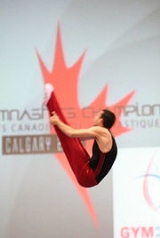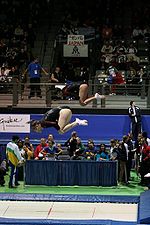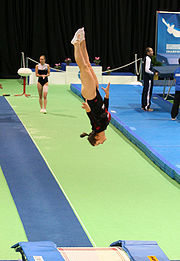
Trampolining
Encyclopedia

Olympic Games
The Olympic Games is a major international event featuring summer and winter sports, in which thousands of athletes participate in a variety of competitions. The Olympic Games have come to be regarded as the world’s foremost sports competition where more than 200 nations participate...
sport
Sport
A Sport is all forms of physical activity which, through casual or organised participation, aim to use, maintain or improve physical fitness and provide entertainment to participants. Sport may be competitive, where a winner or winners can be identified by objective means, and may require a degree...
in which gymnast
Gymnast
Gymnasts are people who participate in the sports of either artistic gymnastics, trampolining, or rhythmic gymnastics.See gymnasium for the origin of the word gymnast from gymnastikos.-Female artistic:Australia...
s perform acrobatics
Acrobatics
Acrobatics is the performance of extraordinary feats of balance, agility and motor coordination. It can be found in many of the performing arts, as well as many sports...
while bouncing on a trampoline
Trampoline
A trampoline is a device consisting of a piece of taut, strong fabric stretched over a steel frame using many coiled springs. People bounce on trampolines for recreational and competitive purposes....
. These can include simple jumps in the pike, tuck or straddle position to more complex combinations of forward or backward somersault
Somersault
A somersault is an acrobatic exercise in which a person does a full 360° flip, moving the feet over the head. A somersault can be performed either forwards, backwards, or sideways and can be executed in the air or on the ground...
s and twists.
There are three related competitive rebound sports, synchronized trampoline, tumbling
Tumbling (gymnastics)
In gymnastics, tumbling, also known as power tumbling is an acrobatic sporting discipline which combines some of the skills of artistic gymnastics on the floor with those of trampolining. It is practised on a 25 metre long spring track...
(or power tumbling) and double mini-trampoline.
Origins
In the early 1930s, George NissenGeorge Nissen
George P. Nissen was an American gymnast and inventor who developed the modern trampoline and made trampolining a worldwide sport.-Background:...
observed trapeze artistes performing tricks when bouncing off the safety net. He made the first modern trampoline in his garage to reproduce this on a smaller scale and used it to help with his diving
Diving
Diving is the sport of jumping or falling into water from a platform or springboard, sometimes while performing acrobatics. Diving is an internationally-recognized sport that is part of the Olympic Games. In addition, unstructured and non-competitive diving is a recreational pastime.Diving is one...
and tumbling activities. He formed a company to build trampolines for sale and used a variant of the Spanish
Spanish language
Spanish , also known as Castilian , is a Romance language in the Ibero-Romance group that evolved from several languages and dialects in central-northern Iberia around the 9th century and gradually spread with the expansion of the Kingdom of Castile into central and southern Iberia during the...
word trampolin (diving board) as a trademark
Trademark
A trademark, trade mark, or trade-mark is a distinctive sign or indicator used by an individual, business organization, or other legal entity to identify that the products or services to consumers with which the trademark appears originate from a unique source, and to distinguish its products or...
. He used the trampoline to entertain audiences and also let them participate in his demonstrations as part of his marketing strategy. These were the beginnings of a new sport.
In the USA, trampolining was quickly introduced into school physical education programs and was also used in private entertainment centres. However, following a number of injuries and law suits caused by insufficient supervision and inadequate training, trampolining is now mostly conducted in specialist gyms with certified trainers. This has caused a large reduction in the number of competitive athletes in the United States and a consequent decline from the earlier American prominence in the sport. Elsewhere in the world the sport was most strongly adopted in Europe and former Soviet Union
Soviet Union
The Soviet Union , officially the Union of Soviet Socialist Republics , was a constitutionally socialist state that existed in Eurasia between 1922 and 1991....
. Since trampolining became an Olympic
Olympic Games
The Olympic Games is a major international event featuring summer and winter sports, in which thousands of athletes participate in a variety of competitions. The Olympic Games have come to be regarded as the world’s foremost sports competition where more than 200 nations participate...
sport in 2000, many more countries have started developing programs and Japan
Japan
Japan is an island nation in East Asia. Located in the Pacific Ocean, it lies to the east of the Sea of Japan, China, North Korea, South Korea and Russia, stretching from the Sea of Okhotsk in the north to the East China Sea and Taiwan in the south...
and China
China
Chinese civilization may refer to:* China for more general discussion of the country.* Chinese culture* Greater China, the transnational community of ethnic Chinese.* History of China* Sinosphere, the area historically affected by Chinese culture...
are already producing very competitive athletes.
Moves
Competitive trampolining routines consist of combinations of 10 contacts with the trampoline bed combining varying rotations, twists and shapes with take-off and landing in one of four positions:- Feet
- Seat
- Front
- Back
A routine must always start and finish on feet. In addition to the 10 contacts with the bed in a routine, competitors are permitted up to one "out bounce", a straight jump to control their height at the end of a routine, before sticking the landing. The trampolinist must stop completely - this means that the bed must stop moving as well - and they have to hold still for a count of 3 seconds before moving.
In competitions, moves must usually be performed in one of the following 3 basic shapes:
| Shape | Method |
|---|---|
| Tucked | with knees clasped to chest by hands |
| Piked | with hands touching close to feet and both arms and legs straight |
| Straight | straight arms, body & legs |
A fourth 'shape', known as 'puck' because it appears to be a hybrid of pike and tuck, is often used in multiple twisting somersaults - it is typically used in place of a 'tuck' and in competition would normally be judged as an open tuck shape.
A straddle, or straddled pike is a variant of a pike with arms and legs spread wide and is only recognised as a move as a shaped jump and not in any somersault moves.
Rotation is performed about the body's longitudinal and lateral axes, producing twists and somersaults respectively. Twists are done in multiples of a half, and somersaults in multiples of a quarter. For example, a barani ball out move consists of a take-off from the back followed by a tucked 1¼ front somersault combined with a ½ twist, to land on feet. Rotation around the dorso-ventral axis is also possible (producing side-somersaults and turntables), but these are not generally considered to be valid moves within competitions and carry no 'tariff' for difficulty.
Individual trampoline

Competition
Competition is a contest between individuals, groups, animals, etc. for territory, a niche, or a location of resources. It arises whenever two and only two strive for a goal which cannot be shared. Competition occurs naturally between living organisms which co-exist in the same environment. For...
were held in colleges and schools in the USA and then in Europe. In the early years of competition there was no defined format with performers often completing lengthy routines and even remounting if falling off partway through. Gradually competitions became more codified such that by the 1950s the 10-bounce routine was the norm thereby paving the way for the first World Championships
Trampoline World Championships
The Trampoline World Championships are the World Championships for trampolining. They were originally held annually from 1964 - 1968. The frequency was switched to biennially from 1970-1998...
which were organised by Ted Blake
Ted Blake
Ted Blake was an early British trampoline pioneer.Following the development of modern trampolines in the USA by George Nissen, Ted Blake was a major contributor to their nascence in the United Kingdom and in developing International Competition for trampolining.In his early years Ted went to the...
of Nissen, and held in London in 1964. The first World Champions were both American, Dan Millman
Dan Millman
Dan Millman is a former Trampolining world champion athlete, university coach, martial arts instructor and college professor, and an author of fourteen self-help books, currently published in 29 languages, the most famous of which is the semi-autobiographical novel, Way of the Peaceful Warrior ,...
and Judy Wills Cline ( both pictured to the right together with members of the Household Cavalry at the closing ceremony). Kurt Baechler of Switzerland
Switzerland
Switzerland name of one of the Swiss cantons. ; ; ; or ), in its full name the Swiss Confederation , is a federal republic consisting of 26 cantons, with Bern as the seat of the federal authorities. The country is situated in Western Europe,Or Central Europe depending on the definition....
and Ted Blake
Ted Blake
Ted Blake was an early British trampoline pioneer.Following the development of modern trampolines in the USA by George Nissen, Ted Blake was a major contributor to their nascence in the United Kingdom and in developing International Competition for trampolining.In his early years Ted went to the...
of England were the Europe
Europe
Europe is, by convention, one of the world's seven continents. Comprising the westernmost peninsula of Eurasia, Europe is generally 'divided' from Asia to its east by the watershed divides of the Ural and Caucasus Mountains, the Ural River, the Caspian and Black Seas, and the waterways connecting...
an pioneers and the first ever televised National Championships were held in England in 1958.
Soon after the first World Championships, an inaugural meeting of prominent trampolinists was held in Frankfurt to explore the formation of an International Trampoline Federation. In 1965 in Twickenham
Twickenham
Twickenham is a large suburban town southwest of central London. It is the administrative headquarters of the London Borough of Richmond upon Thames and one of the locally important district centres identified in the London Plan...
, the Federation was formally recognised as the International Governing Body for the sport. In 1969, the first European Championship was held in Paris
Paris
Paris is the capital and largest city in France, situated on the river Seine, in northern France, at the heart of the Île-de-France region...
and Paul Luxon of London was the winner at the age of 18. The ladies winner was Ute Czech from Germany. From that time until 2010, European and World Championships have taken place in alternate years - the European in the odd and the World in the even. Now the World Championships are held annually.
In 1973, Ted Blake
Ted Blake
Ted Blake was an early British trampoline pioneer.Following the development of modern trampolines in the USA by George Nissen, Ted Blake was a major contributor to their nascence in the United Kingdom and in developing International Competition for trampolining.In his early years Ted went to the...
organised the first World Age Group Competition (WAG) in the newly opened Picketts Lock
Picketts Lock
Pickett's Lock or Picketts Lock is an area of Edmonton, in the London Borough of Enfield. It is bordered by River Lee Navigation to the east, Pickett's Lock Lane to the south, Meridian Way A1055 to the west and the Ponders End industrial area to the north...
Sports Centre; these now run alongside the World Championships. Blake also used the first WAG as an opportunity to organise a World Trampoline Safety Conference which was held in the Bloomsbury Hotel, London, in order to codify safety concerns. There is also a World Cup circuit of international competitions which involves a number of competitions every year. There are also international matches between teams from several countries.
At first the Americans were successful at World Championship level, but soon European competitors began to dominate the sport and for a number of years, athletes from countries that made up the former Soviet Union
Soviet Union
The Soviet Union , officially the Union of Soviet Socialist Republics , was a constitutionally socialist state that existed in Eurasia between 1922 and 1991....
have often dominated the sport. Germany and France have been the other strong nations in trampolining and the first four ranking places in World Trampolining used to go to USSR, France, Britain and Germany. In recent years, Canada
Canada
Canada is a North American country consisting of ten provinces and three territories. Located in the northern part of the continent, it extends from the Atlantic Ocean in the east to the Pacific Ocean in the west, and northward into the Arctic Ocean...
has also produced Olympic medalists and World champions due in large part to contributions made to the sport by Dave Ross
David Ross (trampolinist)
David Ross is a Canadian trampolining coach and manufacturer of trampolines and trampoline equipment. Ross is probably the person most responsible for Canadian trampolinists becoming competitive on the international scene....
. Ross pioneered the sport in Canada almost 30 years ago and consistently produces Olympic and World Cup athletes. Since trampolining became an Olympic sport, China has made a successful effort to develop world-class trampolinists, culminating by winning the 2007 Men's World Championship and both Men's and Women's gold medals and a bronze in the 2008 Olympic Games held in Beijing
Beijing
Beijing , also known as Peking , is the capital of the People's Republic of China and one of the most populous cities in the world, with a population of 19,612,368 as of 2010. The city is the country's political, cultural, and educational center, and home to the headquarters for most of China's...
.
Format
The International Trampolining Federation became part of the Fédération Internationale de GymnastiqueFédération Internationale de Gymnastique
The Fédération Internationale de Gymnastique or International Federation of Gymnastics is the governing body of competitive gymnastics. Its headquarters is in Lausanne, Switzerland. It was founded on July 23, 1881 in Liège, Belgium, making it the oldest international sport organisation...
in 1999. FIG is now the international governing body for the sport which is paired with Tumbling
Tumbling (gymnastics)
In gymnastics, tumbling, also known as power tumbling is an acrobatic sporting discipline which combines some of the skills of artistic gymnastics on the floor with those of trampolining. It is practised on a 25 metre long spring track...
as the skill sets overlap. International competitions are run under the rules of FIG. Individual national gymnastics organizations can make local variations to the rules in matters such as the compulsory and optional routines and number of rounds for national and local competitions.
As part of the agreement to merge FIT with FIG, individual trampolining was accepted into the Summer Olympic Games
Summer Olympic Games
The Summer Olympic Games or the Games of the Olympiad are an international multi-sport event, occurring every four years, organized by the International Olympic Committee. Medals are awarded in each event, with gold medals for first place, silver for second and bronze for third, a tradition that...
for 2000 as an additional gymnastic sport.
The currently accepted basic format for individual trampoline competitions usually consists of two or three routines, one of which may involve a compulsory set of skills
Trampolining terms
Trampolining terms are used to describe various positions and types of skill performed in the sport of trampolining. The sport also has a number of terms which are related to competitions. A number of these terms are unique to trampolining, others are shared with related sports such as gymnastics...
. The skills consist of various combinations of somersault
Somersault
A somersault is an acrobatic exercise in which a person does a full 360° flip, moving the feet over the head. A somersault can be performed either forwards, backwards, or sideways and can be executed in the air or on the ground...
s, shaped bounces, body landings and twists performed in various body positions such as the tuck, pike or straight position.
The routines are performed on a standard 14 foot by 7 foot regulation sized trampoline with a central marker. Each routine consists of the athlete performing ten different skills starting and finishing on the feet. The routine is marked out of 10 by five judges with deductions for incomplete moves, moving too far from the centre mark or poor form. Usually the highest and lowest scores are discarded. Additional points can be added depending on the difficulty of the skills being performed. The degree of difficulty (DD or tariff) is calculated by adding a factor for each half turn (or twist) or quarter somersault.
Difficulty is important in a routine, however, there are differences in opinion between various coaches whether it is better to focus on increasing the difficulty of routines given that this usually results in a reduced form score or to focus on improving execution scores by displaying better form in an easier routine. A new development in senior level competitions in 2010 is to add a "Time of Flight" score to the overall score benefitting athletes who can maintain greater height during their routines.
The official world record DD for men at a FIG
Fédération Internationale de Gymnastique
The Fédération Internationale de Gymnastique or International Federation of Gymnastics is the governing body of competitive gymnastics. Its headquarters is in Lausanne, Switzerland. It was founded on July 23, 1881 in Liège, Belgium, making it the oldest international sport organisation...
sanctioned event is 18.00, achieved by Jason Burnett
Jason Burnett
Jason Nicholas Burnett is a Canadian trampoline gymnast from Etobicoke, Ontario. He is noted for having completed, in training, the world's most difficult trampoline routine with a degree of difficulty of 20.6 and holding the world record of 18.8 for a routine performed in a competition...
of Canada
Canada
Canada is a North American country consisting of ten provinces and three territories. Located in the northern part of the continent, it extends from the Atlantic Ocean in the east to the Pacific Ocean in the west, and northward into the Arctic Ocean...
on April 30, 2010 at the Pacific Rim Championships in Melbourne, Australia. He beat his own world record of 17.50 that he had achieved on April 2, 2007 at the Lake Placid, New York
Lake Placid, New York
Lake Placid is a village in the Adirondack Mountains in Essex County, New York, United States. As of the 2000 census, the village had a population of 2,638....
Trampoline World Cup. Burnett beat the twenty-year-old record of 17.00 by Igor Gelimbatovsky (USSR, 1986) and Daniel Neale (GBR
United Kingdom
The United Kingdom of Great Britain and Northern IrelandIn the United Kingdom and Dependencies, other languages have been officially recognised as legitimate autochthonous languages under the European Charter for Regional or Minority Languages...
, 1999). The top competitors usually perform routines with a DD of 16.5 or greater. In 2009 Jason Burnett completed a training routine with a DD of 20.6 at Skyriders Trampoline Place in Canada.
The women's world record DD is 15.30 by Irina Karavaeva
Irina Karavaeva
Irina Karavayeva is a Russian trampolinist, competing at an international level since 1990.Originally beginning her sports career as a tumbler, Karavayeva soon switched to trampolining and excelled...
(RUS
Russia
Russia or , officially known as both Russia and the Russian Federation , is a country in northern Eurasia. It is a federal semi-presidential republic, comprising 83 federal subjects...
). The top women competitors usually compete routines with a DD greater than 14.50.
The women's synchronised trampoline pair of Karen Cockburn
Karen Cockburn
Karen Cockburn is a Canadian trampoline gymnast.Cockburn was born in Toronto and grew up in North York, Ontario. She began trampolining at age 11, and is a student at York University. She won a bronze medal at the 2000 Summer Olympics in the individual event...
and Rosannagh Maclennan
Rosannagh MacLennan
Rosannagh MacLennan is a Canadian trampoline gymnast. Born in Toronto, Ontario, she won the Canadian National Women's champion in 2005, 2009 and 2011. She has competed internationally at various levels since 1999...
also of Canada completed a new world record DD of 14.20 at the same April 2, 2007 Lake Placid World Cup.
Synchronized trampoline

Double mini-trampoline (DMT)
A double mini-trampoline is smaller than a regulation competition trampoline. It has a sloped end and a flat bed. The gymnasts run up and jump on to the sloping end and then jump on to the flat part before dismounting on to a mat. Skills are performed during the jumps or as they dismount.A double mini-trampoline competition consists of two types of pass. In the one, which is known as a mounter pass, the athlete performs one skill in the jump from the sloping end to the flat bed and a second skill as they dismount from the flat bed to the landing mat. In the second, which is known as a spotter pass, the athlete does a straight jump from the sloping end to the flat bed to gain height, performing one skill while landing back on the flat bed and then a second skill as they dismount. These skills are similar to those performed on a regular trampoline except that there is movement laterally along the trampoline.

Tumbling
Tumbling, also known as power tumbling, is an acrobatic discipline which combines some of the skills of artistic gymnastics on the floor with those of trampolining. It is practised on a 25 metre long sprung track. It was developed from tumbling performances performed by entertainers from very early times but as a sport is now codified, regulated and judged and performed using standardised special equipment.Competitors perform two passes, each containing eight skills including twisting somersault
Somersault
A somersault is an acrobatic exercise in which a person does a full 360° flip, moving the feet over the head. A somersault can be performed either forwards, backwards, or sideways and can be executed in the air or on the ground...
s along the track ending in a 'dismount' skill. The dismounting skill is often another double or triple full or a double or triple back somersault, which can also include extra twists.
Competition safety
Although trampoline competitors are highly trained, they are also attempting to perform complex manoeuvres which could lead to accidents and falls. Trampolines used in competitions have their springs covered in pads to reduce the chance of injury when landing off the bed. They also have padded end decks, which are the locations that athletes are most likely to fall off the trampoline. The rules for International competitions (updated by FIGFédération Internationale de Gymnastique
The Fédération Internationale de Gymnastique or International Federation of Gymnastics is the governing body of competitive gymnastics. Its headquarters is in Lausanne, Switzerland. It was founded on July 23, 1881 in Liège, Belgium, making it the oldest international sport organisation...
in 2006) also require 200mm thick mats on the floor for 2 metres around each trampoline and for there to be four spotters whose task is to attempt to catch or reduce the impact of an athlete falling off the side of the trampoline bed. The floor matting rules are typically adopted by national bodies but not always in full; for example in the UK
United Kingdom
The United Kingdom of Great Britain and Northern IrelandIn the United Kingdom and Dependencies, other languages have been officially recognised as legitimate autochthonous languages under the European Charter for Regional or Minority Languages...
the requirement for National & Regional competition is still 2m but only of 20-25mm matting.

